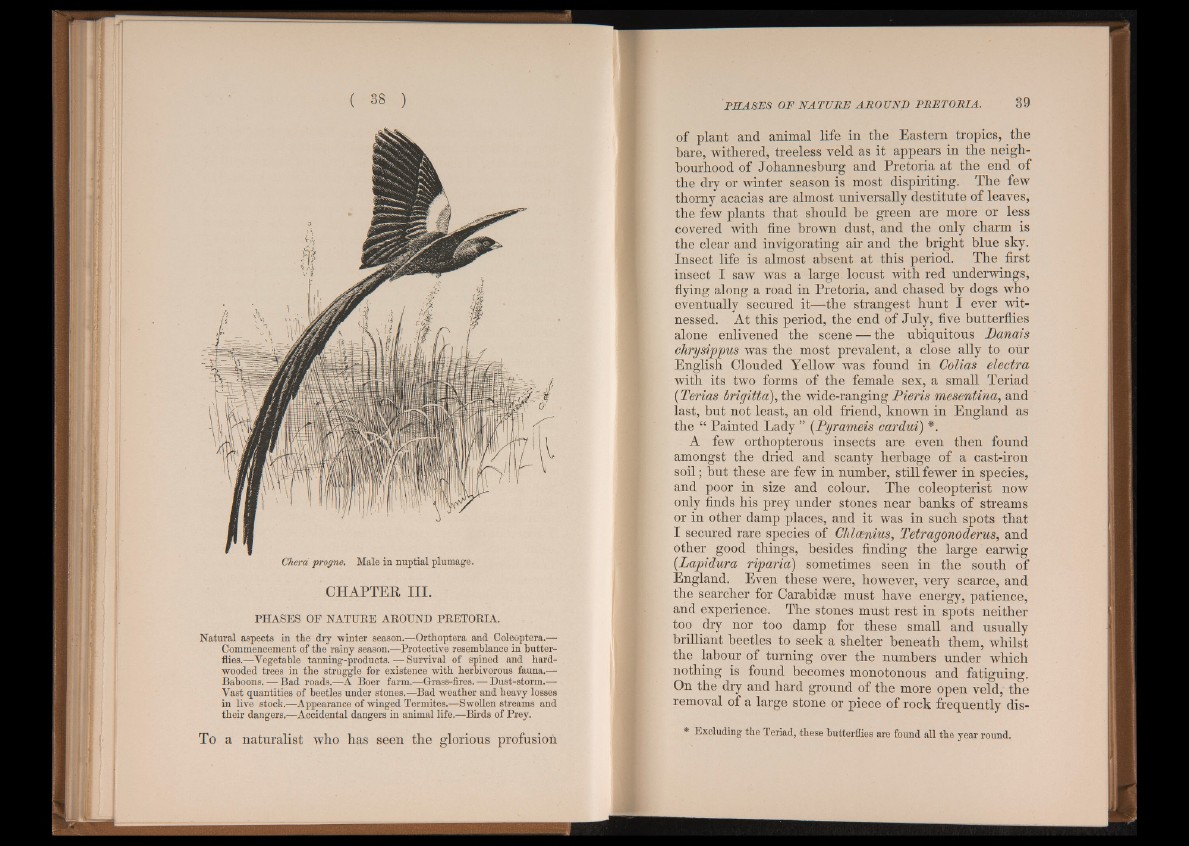
Cher a progne. Male in nuptial plumage.
CHAPTER III.
PHASES OF NATURE AROUND PRETORIA.
Natural aspects in the dry 'winter season.—Orthoptera and Coleóptera.—
Commencement of the rainy seasong-Proteetive resemblance in butterflies.—
Vegetable tanning-products. — Survival of spined and hard-
wooded trees in the struggle for existence with herbivorous fauna.—
Baboons. — Bad roads.—A Boer farm.—Grass-fires. — Dust-storm.—
Vast quantities of beetles under stones.—Bad weather and heavy losses
in live stock.—Appearance of winged Termites.—Swollen streams and
their dangers.—Accidental dangers in animal life.—Birds of Prey.
To a naturalist who has seen the glorious profusion
of plant and animal life in the Eastern tropics, the
bare, withered, treeless veld as it appears in the neighbourhood
of Johannesburg and Pretoria at the end of
the dry or winter season is most dispiriting. The few
thorny acacias are almost universally destitute of leaves,
the few plants that should be green are more or less
covered with fine brown dust, and the only charm is
the clear and invigorating air and the bright blue sky.
Insect life is almost absent at this period. The first
insect I saw was a large locust with red underwings,
flying along a road in Pretoria, and chased by dogs who
eventually secured it—the strangest hunt I ever witnessed.
At this period, the end of July, five butterflies
alone enlivened the scene — the ubiquitous Danais
chrysippus was the most prevalent, a close ally to our
English Clouded Yellow was found in Colias electra
with its two forms of the female sex, a small Teriad
(Terias brigitta), the wide-ranging Pieris mesentina, and
last, but not least, an old friend, known in England as
the “ Painted Lady ” (Pyrameis cardui) *.
A few orthopterous insects are even then found
amongst the dried and scanty herbage of a cast-iron
soil; but these are few in number, still fewer in species,
and poor in size and colour. The coleopterist now
only finds his prey under stones near banks of streams
or in other damp places, and it was in such spots that
I secured rare species of Chlasnius, Tetragonoderus, and
other good things, besides finding the large earwig
(Lapidura riparia) sometimes seen in the south of
England. Even these were, however, very scarce, and
the searcher for Carabidge must have energy, patience,
and experience. The stones must rest in spots neither
too dry nor too damp for these small and usually
brilliant beetles to seek a shelter beneath them, whilst
the labour of turning over the numbers under which
nothing is found becomes monotonous and fatiguing.
On the dry and hard ground of the more open veld, the
removal of a large stone or piece of rock frequently dis-
* Excluding the Teriad, these butterflies are found all the year round.